Note 14/12/2006: Excel Table 23 State Final Demand, Detailed Components, Victoria has been re-issued on Thursday 14 December 2006 and includes previously missing current price and revisions data.
Note 12/12/2006: Time Series Table 23 State Final Demand, Detailed Components, Victoria has been re-issued. This has corrected errors in the historical time series for Victorian State Final Demand, Volume measure and Public Final Demand, Volume measure (both trend and seasonally adjusted). No other series have been affected.
SEPTEMBER KEY FIGURES
GDP growth rates, Volume measures, quarterly change
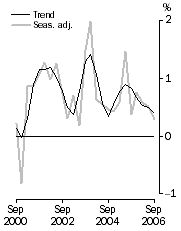
| Contributions to GDP growth, Expenditure - Seasonally adjusted
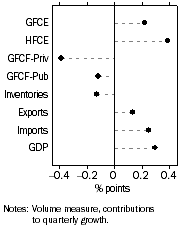
|
SEPTEMBER KEY POINTS
VOLUME GDP
- In trend terms, GDP increased by 0.4% in the September quarter and Non-farm GDP increased by 0.6%. Real net national disposable income grew by 0.6%.
- In seasonally adjusted terms, GDP increased by 0.3% in the September quarter, Non-farm GDP increased by 0.6% and the Terms of trade increased by 2.0%.
EXPENDITURE ON GDP
- In seasonally adjusted terms, the increase in expenditure on GDP was a result of positive contributions from Household final consumption expenditure (+0.4 percentage points) and Net exports of goods and services (+0.4 percentage points). This growth was offset by negative contributions from Private business investment (-0.2 percentage points) and Changes in inventories (-0.1 percentage points).
INDUSTRY GROSS VALUE ADDED
- In seasonally adjusted terms, Mining (0.3 percentage points) and Finance and Insurance (0.2 percentage points) contributed to GDP growth. This was offset by a negative contribution from Agriculture, forestry and fishing (-0.3 percentage points).
NOTES
FORTHCOMING ISSUES
| ISSUE (QUARTER) | Release Date |
| December 2006 | 7 March 2007 |
| March 2007 | 6 June 2007 |
| June 2007 | 5 September 2007 |
FEATURE ARTICLE
An article, The impact of the drought on agricultural production in 2006-07 is being released with this publication and is available on the ABS website.
REVISIONS IN THIS ISSUE
Revisions have been made to a number of aggregates. The causes of the revisions fall into three categories:
- the quarterly series have been benchmarked to revised estimates from the annual supply and use tables for 2002-03 to 2004-05. The revised annual benchmarks were first published in the Australian System of National Accounts (cat. no. 5204.0) released on 1 November 2006.
- the normal quarterly revisions due to the incorporation of more up-to-date source data. Of note is a revision to source data for two series: private investment in engineering construction and construction industry value added, which has lead to upward revisions in those series for the quarters of 2005-06.
- the annual seasonal reanalysis that is undertaken on all series. This has caused revisions in all seasonally adjusted series to varying degrees.
The effect of these revisions has been to increase growth in the volume measure of GDP in June quarter 2006 by 0.2 percentage points.
CHANGES IN THIS ISSUE
With the release of this publication, two new Excel spreadsheets have been included:
- 37 - Indexes of Industrial Production
- 38 - Unit labour costs.
CHANGES IN THE NEXT ISSUE
The method of estimating seasonally adjusted and trend estimates of GDP and its component series will change to concurrent seasonal adjustment from the next issue of this publication.
INQUIRIES
For further information about these and related statistics, contact the National Information and Referral Service on 1300 135 070 or Terry Rawnsley on Canberra (02) 6252 6711.
MAIN FEATURES EXPENDITURE CHAIN VOLUME MEASURES
 |  |  | Trend | Seasonally adjusted |  |
 |  |  | % change
Jun 06
to Sep 06 | % change
Sep 05
to Sep 06 | % points contribution
to growth in GDP
Jun 06 to Sep 06 | % change
Jun 06
to Sep 06 | % change
Sep 05
to Sep 06 | % points contribution
to growth in GDP
Jun 06 to Sep 06 |  |
|  |
| Final consumption expenditure |  |  |  |  |  |  |  |
 | General government | 1.1 | 4.7 | 0.2 | 1.2 | 5.3 | 0.2 |  |
 | Households | 0.7 | 2.9 | 0.4 | 0.7 | 2.8 | 0.4 |  |
| Gross fixed capital formation |  |  |  |  |  |  |  |
 | Private |  |  |  |  |  |  |  |
 |  | Dwellings | 1.7 | -0.5 | 0.1 | 0.6 | -0.6 | - |  |
 |  | Business investment | -0.6 | 4.9 | -0.1 | -1.4 | 4.7 | -0.2 |  |
 |  | Ownership transfer costs | -1.6 | 4.1 | - | -11.9 | 0.7 | -0.2 |  |
 | Public | - | 4.4 | - | -2.9 | 4.6 | -0.1 |  |
| Changes in inventories |  |  |  |  |  |  |  |
 | Private non-farm | . . | . . | -0.4 | . . | . . | -0.2 |  |
 | Farm and public authority | . . | . . | - | . . | . . | 0.1 |  |
| Gross national expenditure | 0.2 | 2.3 | 0.2 | - | 2.6 | - |  |
| Exports of goods and services | 1.2 | 4.6 | 0.2 | 0.7 | 6.0 | 0.1 |  |
| Imports of goods and services | 0.7 | 6.5 | -0.2 | -1.1 | 7.3 | 0.2 |  |
| Statistical discrepancy (E) | . . | . . | 0.1 | . . | . . | -0.1 |  |
| Gross domestic product | 0.4 | 2.1 | 0.4 | 0.3 | 2.2 | 0.3 |  |
|  |
| . . not applicable |
| - nil or rounded to zero (including null cells) |
SEPTEMBER QUARTER
Summary Comments
Final Consumption Expenditure
- Household final consumption expenditure grew by 0.7% in both trend and seasonally adjusted terms during the quarter, with the main contributors to growth being Rent and other dwelling services, Furnishings and household equipment and Recreation and culture.
Gross fixed capital formation (GFCF)
- Private business investment fell by 0.6% in trend terms (1.4% seasonally adjusted). The seasonally adjusted fall was due in most part to Machinery and equipment GFCF (down 3.6%). Dwellings GFCF increased by 1.7% in trend terms (0.6% seasonally adjusted). In seasonally adjusted terms, New Dwellings GFCF decreased by 0.5%, while investment on Alterations and additions increased by 1.8% following a 6.0% increase in the June quarter.
Changes in inventories
- Total inventories decreased by $1,352m in trend terms, which followed a decrease of $419m in the June quarter. In seasonally adjusted terms inventories fell by $1,192m compared to a fall of $899m in the June quarter. As a result, changes in inventories detracted 0.1 percentage points from seasonally adjusted GDP growth during the quarter.
Exports and imports of goods and services
- In trend terms, Exports of goods and services increased 1.2% (0.7% seasonally adjusted). Seasonally adjusted Exports of services increased by 1.7%, and Exports of goods increased by 0.4%.
- Imports of goods and services increased by 0.7% in trend terms. Imports fell 1.1% seasonally adjusted as a result of a -3.7% (-$393m) fall in the import of capital goods.
MAIN FEATURES PRODUCTION CHAIN VOLUME MEASURES
 | Trend | Seasonally adjusted |  |
 | % change
Jun 06
to Sep 06 | % change
Sep 05
to Sep 06 | % points contribution
to growth in GDP
Jun 06 to Sep 06 | % change
Jun 06
to Sep 06 | % change
Sep 05
to Sep 06 | % points contribution
to growth in GDP
Jun 06 to Sep 06 |  |
|  |
| Agriculture, forestry and fishing | -5.1 | -7.1 | -0.1 | -9.1 | -10.2 | -0.3 |  |
| Mining | 2.0 | -1.3 | 0.1 | 7.2 | 4.6 | 0.3 |  |
| Manufacturing | 0.3 | -1.8 | - | 0.9 | -1.5 | 0.1 |  |
| Electricity, gas and water supply | 0.7 | 4.9 | - | -2.0 | 4.4 | - |  |
| Construction | 1.4 | 6.9 | 0.1 | -0.5 | 5.9 | - |  |
| Wholesale trade | -0.3 | 0.8 | - | -1.0 | 0.8 | - |  |
| Retail trade | 0.7 | 2.9 | - | 0.6 | 2.7 | - |  |
| Accommodation, cafes and restaurants | - | 1.7 | - | -0.2 | 1.7 | - |  |
| Transport and storage | 1.0 | 3.7 | - | 0.5 | 3.3 | - |  |
| Communication services | 0.5 | 6.3 | - | 0.2 | 6.7 | - |  |
| Finance and insurance | 1.9 | 7.5 | 0.1 | 2.1 | 7.6 | 0.2 |  |
| Property and business services | 0.5 | 3.8 | 0.1 | 0.2 | 4.6 | - |  |
| Government administration and defence | 1.2 | 3.6 | - | 1.9 | 3.9 | 0.1 |  |
| Education | 0.4 | 1.6 | - | 0.4 | 1.6 | - |  |
| Health and community services | 0.3 | 2.3 | - | 0.1 | 2.3 | - |  |
| Cultural and recreational services | 0.2 | -0.2 | - | 0.1 | -0.8 | - |  |
| Personal and other services | 0.9 | 3.8 | - | -0.5 | 2.4 | - |  |
| Ownership of dwellings | 0.9 | 3.8 | 0.1 | 1.0 | 3.8 | 0.1 |  |
| Taxes less subsidies on products | 0.2 | 1.3 | - | -0.2 | 1.0 | - |  |
| Statistical discrepancy (P) | . . | . . | -0.1 | . . | . . | -0.1 |  |
| Gross domestic product | 0.4 | 2.1 | 0.4 | 0.3 | 2.2 | 0.3 |  |
|  |
| . . not applicable |
| - nil or rounded to zero (including null cells) |
SEPTEMBER QUARTER
Summary Comments
Agriculture, Forestry and Fishing
- The trend estimate fell by 5.1% and the seasonally adjusted estimate by 9.1%. The main contributors to the seasonally adjusted fall were Cereal crop production (down 34.7%), Non-cereal crop production (down 5.1%) and Services to agriculture (down 5.1%).
Mining
- The trend estimate was 2.0% higher and the seasonally adjusted estimate was 7.2% higher than the June quarter. The main contributor to this result was higher Oil and gas production activity. However, through the year, Mining fell by 1.3% in trend terms, with falls in Oil and gas production and Gold production.
Manufacturing
- The trend estimate increased by 0.3% (0.9% seasonally adjusted). The main industries to increase, in seasonally adjusted terms, were Metal products (5.9%) and Food, beverages and tobacco (4.3%). These rises were partly offset by falls in Other manufacturing (8.7%) and Chemical, petroleum and coal products (6.6%).
Construction
- The trend estimate increased by 1.4% while the seasonally adjusted estimate fell by 0.5%. A fall in Other construction activity (down 4.4%) outweighed higher Residential building (up 1.8%) and Non-residential building (up 2.3%).
Wholesale and Retail Trade
- In trend terms Wholesale fell by 0.3% while Retail increased by 0.7%. In seasonally adjusted, terms Wholesale declined by 1.0% while Retail increased by 0.6%. The largest contributors to the fall within wholesale trade were Machinery, Motor vehicles and Computers.
MAIN FEATURES INCOME AT CURRENT PRICES
 |  | Trend | Seasonally adjusted |  |
 |  | % change
Jun 06
to Sep 06 | % change
Sep 05
to Sep 06 | % points contribution
to growth in GDP
Jun 06 to Sep 06 | % change
Jun 06
to Sep 06 | % change
Sep 05
to Sep 06 | % points contribution
to growth in GDP
Jun 06 to Sep 06 |  |
|  |
| Compensation of employees | 1.7 | 6.9 | 0.8 | 1.8 | 7.0 | 0.9 |  |
| Gross operating surplus |  |  |  |  |  |  |  |
 | Private | 2.2 | 8.3 | 0.4 | 3.6 | 9.6 | 0.7 |  |
 | Other | 1.8 | 8.6 | 0.3 | 1.7 | 8.6 | 0.2 |  |
| Gross mixed income | -1.9 | -1.7 | -0.2 | -3.9 | -2.6 | -0.3 |  |
| Taxes less subsidies on production and imports | 1.6 | 6.0 | 0.2 | 1.4 | 5.4 | 0.2 |  |
| Statistical discrepancy (I) | . . | . . | - | . . | . . | 0.2 |  |
| Gross domestic product | 1.6 | 6.8 | 1.6 | 1.8 | 7.3 | 1.8 |  |
|  |
| . . not applicable |
| - nil or rounded to zero (including null cells) |
SEPTEMBER QUARTER
Summary Comments
Compensation of employees(COE)
- The trend increase of 1.7% in the September quarter reflected a rise of 0.8% in average earnings and a 0.9% rise in the number of wage and salary earners. Seasonally adjusted, COE grew by 1.8%. Average earnings increased by 0.7%, while the number of wage and salary earners increased by 1.1%. COE represented 53.8% of total factor income in the September quarter.
Wages(a) share of total factor income: Trend
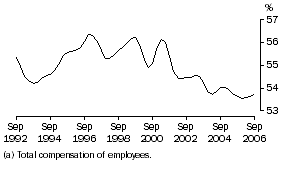
Gross operating surplus (GOS)
- GOS of corporations remained at historically high levels, representing 27.5% of total factor income in the quarter. The quarter saw a 2.3% increase in trend GOS and a 3.3% increase in seasonally adjusted terms. The seasonally adjusted increase was stronger than the increase in each of the previous two quarters.
Profit(a) share of total factor income: Trend
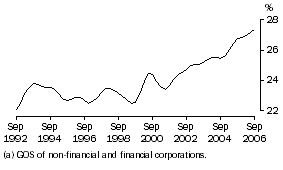
MAIN FEATURES STATE FINAL DEMAND CHAIN VOLUME MEASURES
 | Trend | Seasonally adjusted |  |
 | % change
Jun 06
to Sep 06 | % change
Sep 05
to Sep 06 | % points contribution
to growth in DFD
Jun 06 to Sep 06 | % change
Jun 06
to Sep 06 | % change
Sep 05
to Sep 06 | % points contribution
to growth in DFD
Jun 06 to Sep 06 |  |
|  |
| New South Wales | -0.1 | 0.6 | - | -0.3 | 0.8 | -0.1 |  |
| Victoria | 0.4 | 1.6 | 0.1 | 0.5 | 2.1 | 0.1 |  |
| Queensland | 1.9 | 8.0 | 0.4 | 2.6 | 8.1 | 0.5 |  |
| South Australia | 0.7 | 1.8 | - | 1.3 | 2.7 | 0.1 |  |
| Western Australia | 0.7 | 9.3 | 0.1 | -3.4 | 7.0 | -0.4 |  |
| Tasmania | -0.9 | -2.5 | - | -3.6 | -5.6 | -0.1 |  |
| Northern Territory | 1.5 | 4.2 | - | 4.6 | 7.8 | 0.1 |  |
| Australian Capital Territory | 0.6 | 4.8 | - | -1.8 | 4.2 | -0.1 |  |
| Australia (DFD)(a) | 0.6 | 3.4 | 0.6 | 0.1 | 3.4 | 0.1 |  |
|  |
| - nil or rounded to zero (including null cells) |
| (a) Domestic final demand. |
SEPTEMBER QUARTER
Summary Comments
State Final Demand
- In trend terms, growth in the September quarter was strongest in Queensland (up 1.9%) and the Northern Territory (up 1.5%), and weakest in Tasmania (down 0.9%). In seasonally adjusted terms, the Northern Territory (up 4.6%) showed the strongest growth with the major contributor being private gross fixed capital formation. Seasonally adjusted growth was weakest in Tasmania (down 3.6%), due mainly to a decline in public gross fixed capital formation, followed by Western Australia (down 3.4%), due predominantly to a decline in private gross fixed capital formation.
Household final consumption expenditure
- In trend terms, all states experienced growth ranging from 1.1% in Western Australia to a low of 0.5% in Tasmania. Growth in seasonally adjusted terms was recorded in all states with the strongest growth in Western Australia (up 1.1%).
Government final consumption expenditure
- In trend terms, all states experienced growth in government final consumption expenditure with the strongest growth in Queensland (up 1.6%). Seasonally adjusted growth fell in the Australian Capital Territory (down 0.4%), while all other states recorded growth with the strongest in South Australia (up 2.6%).
Private gross fixed capital formation
- In trend terms, the strongest growth was recorded in the Australian Capital Territory (up 3.7%). Trend growth was weakest in Tasmania (down 6.3%). In seasonally adjusted terms the strongest growth was recorded in the Northern Territory (up 12.2%), with the weakest growth in Western Australia (down 10.1%).
- In seasonally adjusted terms, investment in machinery and equipment was mixed, with the Northern Territory recording the strongest growth (up 12.2%), while Tasmania recorded the largest fall (down 23.4%). The strongest growth in non-dwelling construction occurred in the Northern Territory (up 29.4%), with the weakest growth in the Australian Capital Territory (down 20.6%).
Public gross fixed capital formation
- Trend growth was strongest in Queensland (up 9.4%), while the largest fall was recorded in the Australian Capital Territory (down 10.6%). In seasonally adjusted terms, strong growth was recorded in Queensland (up 23.9%), while a large fall occurred in Tasmania (down 60.2%).
ANALYSIS AND COMMENTS
GROWTH RATES IN GDP
Following the fall in GDP (in seasonally adjusted volume terms) in December quarter 2000, there have been 23 consecutive quarters of growth, averaging around 0.8% per quarter.
Percentage changes, Volume measures
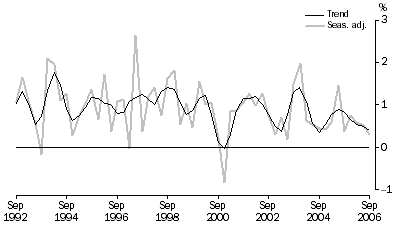
The growth (in trend volume terms) over the past four quarters was driven by Household final consumption expenditure (up 2.9%), Non dwelling construction investment (up 9.6%) and Total public gross fixed capital formation (up 4.4%).
Offsetting the growth during the past four quarters was a strong rise in Imports of goods and services (up 6.5%) and negative contributions from Changes in inventories.
On the production side, the strongest industries (in trend volume terms) over the past four quarters have been Construction, Property and business services and Finance and insurance (all contributing 0.5 percentage points to GDP growth). Agriculture and Manufacturing both detracted 0.2 percentage points from GDP growth over the past four quarters.
Selected Industries Contribution to growth, Sep qtr 05 to Sep qtr 06: Trend
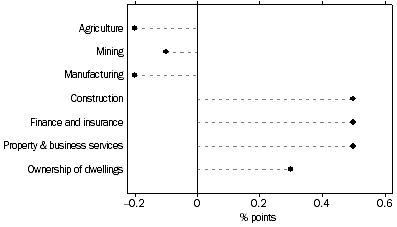
REAL GROSS DOMESTIC INCOME
The real purchasing power of income generated by domestic production can be affected by changes in import and export prices. Real gross domestic income adjusts the chain volume measure of GDP by the Terms of trade. The graph below provides a comparison of quarterly movements in trend GDP (volume measure) and Real gross domestic income. During the September quarter, trend Real gross domestic income increased by 0.8%, compared to the increase in the trend volume measure of GDP of 0.4%, reflecting a 1.1% improvement in the trend Terms of trade.
Percentage changes, Trend
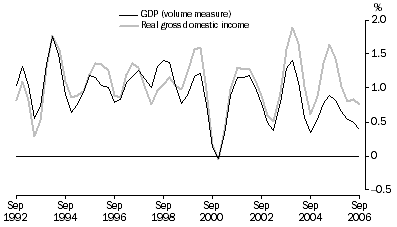
TERMS OF TRADE
The Terms of trade represent the relationship between the prices of exports and imports. An increase (decrease) in the Terms of trade reflects export prices increasing (decreasing) at a faster rate than import prices. The strong growth in the Terms of trade from September quarter 2003 (up 31.2%) reflected over 30% growth in export prices and relatively flat import prices over the period. The September quarter 2006 saw a 1.1% increase in trend terms to a record high since September quarter 1959 in the Terms of trade index.
Trend, (2004-05 = 100)
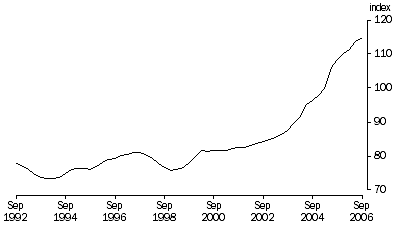
REAL NET NATIONAL DISPOSABLE INCOME
A broader measure of change in national economic well-being is Real net national disposable income. This measure adjusts the volume measure of GDP for the Terms of trade effect, Real net incomes from overseas and Consumption of fixed capital (see Glossary for definition). The graph below provides a comparison of quarterly movements in trend GDP (volume measure) and Real net national disposable income. During the September quarter, trend Real net national disposable income increased by 0.6%, with growth over the past four quarters at 3.1% compared to 2.1% for GDP.
Percentage changes, Trend
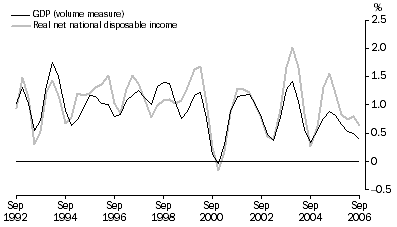
NET EXPORTS CONTRIBUTION TO GROWTH
Net exports represent the difference between exports and imports. Net exports contribute to GDP growth when the change in the volume of exports has been greater than the change in the volume of imports. In the September quarter, Net exports contributed 0.1 percentage points to GDP in trend terms. This was the first positive contribution since June quarter 2001.
Net Exports Contribution to growth, Volume measures
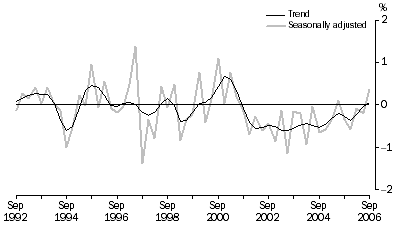
HOUSEHOLD SAVING RATIO
In both trend (-1.0%) and seasonally adjusted (-0.9%) terms the Household saving ratio was negative in September quarter 2006, implying that household consumption was greater than household disposable income.
Household savings cannot be directly measured. Rather it is calculated as a residual item by deducting Household final consumption expenditure from Household gross disposable income. As the difference between the two aggregates is relatively small, caution should be exercised in interpreting the Household saving ratio in recent years, because major components of household income and expenditure may be subject to significant revisions. The impact of these revisions on the saving ratio can cause changes in the direction of the trend.
Household saving ratio, Current prices
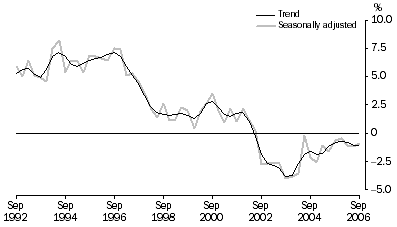
COMPENSATION OF EMPLOYEES
In September quarter 2006, seasonally adjusted Compensation of employees grew by 1.8%, while the seasonally adjusted number of employees recorded in the Labour Force survey grew by 1.1%. Average compensation per employee increased by 0.7%. Through the year growth in average compensation per employee was 4.1% compared to 3.8% growth over the same period in the total hourly rates of pay, excluding bonuses as published in Labour Price Index, Australia (cat. no. 6345.0). It should be noted that the conceptual bases for these two wage measures are different.
PRIVATE NON-FARM INVENTORIES
Changes in inventories can have a significant impact on the growth in GDP in any particular quarter. A positive change in inventories can be seen as production increasing at a faster rate than consumption but the exact reasons underlying changes in inventories can be far more complex. For example, firms may run up or run down inventories in anticipation of future sales, supply constraints could affect inventories, or firms may under or over estimate sales in a particular period.
The graph below shows GDP growth and the Changes in inventories contribution to GDP growth in trend terms. The Changes in inventories contribution to GDP growth is quite volatile. However, since the December quarter 2003, Changes in inventories have only had a positive contribution to GDP growth in one quarter (0.1 percentage point in September quarter 2005).
Inventories and GDP: Trend
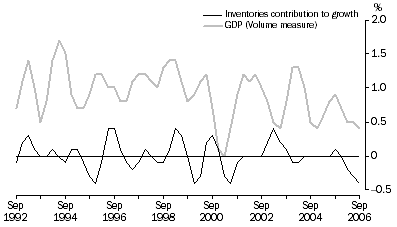
Changes in inventories can be disaggregated into a number of industries. The graph below shows the three largest sectors, Manufacturing, Wholesale and Retail . Over the past year all three industries have exhibited a downwards trend in changes in inventories. For more details see Table 22.
Change in inventories, Selected industries: Trend
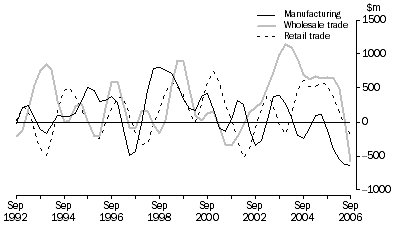
In trend current price terms, the book value of Private non-farm inventories decreased 0.6% in September quarter 2006, while total sales increased by 0.5%. Consequently, as sales have risen at a faster rate than inventories, the Private non-farm inventories to total sales ratio decreased from 0.709 in the June quarter to 0.699 in the September quarter.
Trend, Current prices
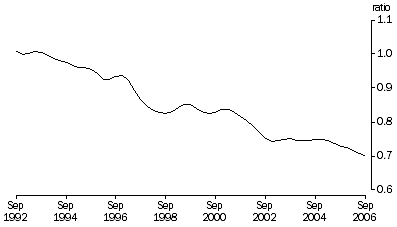
IMPORTS TO DOMESTIC SALES
The Imports to domestic sales ratio, trended and at current prices, decreased from 0.361 in the June quarter to 0.360 in the September quarter. This reflected an increase of 1.0% in Imports of goods accompanied by a 1.1% rise in Domestic sales.
Trend, Current prices
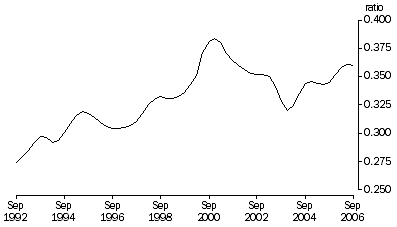
RELIABILITY OF CONTEMPORARY TREND ESTIMATES
Trend estimates are used throughout this publication as an alternative approach to the analysis of movements in time series data. Further details regarding the procedures used to estimate the trend series are described in the Explanatory Notes (paragraphs 13 - 17) and in Information Paper: A Guide to Interpreting Time Series - Monitoring Trends, 2003 (cat. no. 1349.0) released in August 2003.
Potential revisions to trend estimates can be indicated by showing the effects of particular changes in seasonally adjusted estimates that might occur in the next quarter. The table below shows the trend estimates for the last ten quarters and the values to which they would be revised if the given movements in seasonally adjusted GDP actually occurred in December quarter 2006. In the absence of any other revisions, seasonally adjusted growth of 0.4% is required in December quarter 2006 to maintain, in December quarter 2006, the trend growth of 0.4% currently estimated for the September quarter 2006.
Percentage change in GDP Chain volume measure |
|  |
 |  |  |  | Trend estimate if seasonally adjusted GDP changes by the following amounts in December qtr 2006 |  |
 |  | Seasonally adjusted GDP
as published in table 2 | Trend GDP as
published in table 1 | Grows by 1.0% | No change | Falls by 1.0% |  |
|  |
| 2004 |  |  |  |  |  |  |
 | June | 0.6 | 0.6 | 0.6 | 0.6 | 0.6 |  |
 | September | 0.5 | 0.4 | 0.4 | 0.4 | 0.4 |  |
 | December | 0.4 | 0.5 | 0.5 | 0.5 | 0.5 |  |
| 2005 |  |  |  |  |  |  |
 | March | 0.6 | 0.8 | 0.8 | 0.8 | 0.8 |  |
 | June | 1.5 | 0.9 | 0.9 | 0.9 | 0.9 |  |
 | September | 0.4 | 0.8 | 0.8 | 0.8 | 0.8 |  |
 | December | 0.8 | 0.7 | 0.7 | 0.7 | 0.7 |  |
| 2006 |  |  |  |  |  |  |
 | March | 0.6 | 0.5 | 0.5 | 0.6 | 0.6 |  |
 | June | 0.5 | 0.5 | 0.5 | 0.5 | 0.4 |  |
 | September | 0.3 | 0.4 | 0.6 | 0.3 | - |  |
|  |
| - nil or rounded to zero (including null cells) |
CONCURRENT SEASONAL ADJUSTMENT
INTRODUCTION
The ABS is in the process of introducing concurrent adjustment for all seasonally adjusted indicators. The ABS has previously outlined the advantages of concurrent seasonal adjustment methodology and implemented this method on several main ABS economic indicators. One such economic indicator containing a comparison analysis of concurrent seasonal adjustment is available on the ABS website - Information Paper: Introduction of Concurrent Seasonal Adjustment into the Retail Trade Series (cat. no. 8514.0) released in December 1999. Users' responses to these changes have been positive. A more detailed explanation of concurrent seasonal adjustment is available on the ABS website - Use of concurrent seasonal adjustment for economic time series: the case for Retail Survey (refer to the ABS Methodology Advisory Committee for June 2001 available from the ABS website).
The ABS will introduce concurrent seasonal adjustment into the quarterly Australian National Accounts: National Income, Expenditure and Product (cat. no. 5206.0 ) for GDP and its component series from the December quarter 2006 issue.
EXPLANATION OF CONCURRENT SEASONAL ADJUSTMENT AND FORWARD FACTORS
The seasonal adjustment process uses estimated factors to remove the effects of normal seasonal variation from the original estimates. These factors are estimated by analysing historical patterns to determine the significance and direction of these systematic influences. There are two approaches used to do this, known as forward factor and concurrent adjustment.
Forward factor seasonal adjustment relies on an annual analysis of the latest available data to determine factors (known as forward factors) that will be applied in the forthcoming four quarters. The advantage of this approach is that estimates of seasonal factors will only be revised on an annual basis. However, the seasonal factors produced by this method can become out of date with the addition of further original estimates. Under forward factor adjustment, revisions to the seasonally adjusted estimates are hidden essentially as they occur only at the time of annual reanalysis. The method is not as responsive to emerging changes in seasonal patterns.
Concurrent seasonal adjustment uses the data available at the current reference period to estimate seasonal factors for the current and previous quarters. Under this method, the estimates of the seasonal factors are fine tuned as new original estimates become available each period. The seasonally adjusted estimates are subject to revisions at each reference quarter as the estimates of seasonal factors are improved. This method eliminates the need for projecting forward factors, and can result in significant improvements in the accuracy and consistency of the seasonally adjusted series.
IMPLICATIONS OF CHANGING METHODOLOGY TO CONCURRENT ADJUSTMENT
The estimates of combined seasonal adjustment factors are currently only amended once a year, in the September reference quarter following the annual seasonal reanalysis. Concurrent adjustment will result in the combined seasonal adjustment factors and the seasonally adjusted estimates being updated each quarter rather than only once a year.
It will still be necessary to undertake an annual seasonal reanalysis of the Current Account series. The annual reanalysis for the concurrent method is used to review details of seasonally adjusted methods used, examine time series for outliers or unusual data, or for changing seasonality and structural breaks. It is possible that some issues will only gradually emerge over a number of quarters and may not be as obvious when the focus is on concurrent adjustment. The annual seasonal reanalysis should not result in significant revisions to combined seasonal adjustment factors, as combined seasonal adjustment factors and therefore seasonally adjusted estimates will be revised each quarter as a result of concurrent adjustment.
For further information on concurrent adjustment, please contact the Assistant Director, Time Series Analysis on Canberra 02 6252 6345 or by email at timeseries@abs.gov.au.
RECENT RELEASES
AUSTRALIAN SYSTEM OF NATIONAL ACCOUNTS, 2005-06 (CAT. NO. 5204.0)
The Annual National Accounts publication, released on 1 November 2006, provides estimates for gross domestic product (GDP) and its components, the national income account, the national capital account, the national financial account and the national balance sheet. Income, capital and financial accounts and a balance sheet are provided for each sector of the economy. Also provided is a range of information classified by industry, details of capital formation (including capital stocks) and productivity statistics.
The ABS is in the process of migrating from a traditional paper-based publishing regime to a web-based publishing regime. With the ability to hyperlink information on the web site, there are new and innovative ways for effective communication to users of ABS information. The Annual National Accounts publication has taken some steps towards a full web-based publishing regime. While a PDF containing the majority of material within this publication has been produced, the commentary, is more effectively viewed on the ABS website. The ABS is looking for your feedback to help us improve future issues.
AUSTRALIAN NATIONAL ACCOUNTS, STATE ACCOUNTS (CAT. NO. 5220.0)
The State Accounts published on 13 November 2006 included are estimates of Gross state product and State final demand and its major components. These components include, household final consumption expenditure, government final consumption expenditure, private and public gross fixed capital formation and international trade. Household income by state and territory are also included in the publication.
IMPLEMENTING NEW ESTIMATES OF HOURS WORKED INTO THE AUSTRALIAN NATIONAL ACCOUNTS, 2006 (CAT. NO. 5204.0.55.003)
The ABS publishes indexes of hours worked in annual and quarterly national accounts. These indexes capture underlying trends in hours worked and are derived from estimates of hours actually worked by employed people. The ABS Labour Force Survey (LFS) provide the basic data from which these indexes are constructed. The hours worked indexes published in the National Accounts are important indicators in their own right as well as being fundamental building blocks required to estimate the indexes of labour productivity and multifactor productivity.
Over the past year, the ABS has considered options for improving the methodology used for estimating total hours worked and average hours worked per employee. This work has focused on improving the annual measures of both total and average hours worked.
This paper, released on 1 November 2006, describes both the previous and new methods used for estimating hours worked and gives an overview of the effect of the change on the hours worked index and related productivity indexes.
SPOTLIGHT ON NATIONAL ACCOUNTS (CAT. NO. 5202.0)
On 15 November 2006, the ABS released the first issue of a new product, Spotlight on National Accounts (cat. no. 5202.0). The first Spotlight on National Accounts focused on 'Broader measures of progress other than Gross domestic product (GDP)'. Spotlight on National Accounts will consist of a relatively short piece of analysis that will focus on a particular theme. The themes to be explored aim to:
- Provide users with increased understanding of the national accounts and associated ABS products
- Provide statistical information on the underlying causes of certain economic phenomena
- Inform users of improvements to concepts, sources and methods used in the National Accounts.
Producing Spotlights on National Accounts based on these aims will help expand users understanding of the compilation of the national accounts and their relationship to other statistics published by the ABS. Spotlight on National Accounts will be a web-based product released on an irregular basis. The web-base nature of the product will allow hyper-linking to more detailed information currently available on the ABS website.
It is anticipated that over the next 12 months there will be four to six releases of Spotlight on National Accounts. The future topics may include an overview of the Household saving ratio, analysis of quarterly Labour productivity and a description of Mining related statistics.
A SUPPLY AND USE MODEL FOR EDITING THE QUARTERLY NATIONAL ACCOUNTS, AUSTRALIA, RESEARCH PAPER, 2006 (CAT. NO. 5258.0)
Released on 1 December 2006, this product describes the underlying framework of the experimental quarterly supply and use (QSU) model, its overall structure and how it is being used to aid the editing of quarterly Australian national accounts data. The ABS has developed and is experimenting with the use of a quarterly supply and use model as a data editing tool. It utilises the existing quarterly national accounts data and models the remaining data that are required in a supply and use approach.
 Print Page
Print Page
 Print All
Print All